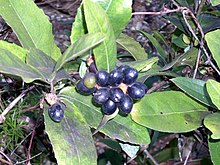Wilkiea hugeliana
| Veiny wilkiea | |
|---|---|

| |
| Wilkiea hugeliana at Macquarie Pass National Park | |
| Scientific classification | |
| Kingdom: | Plantae |
| Clade: | Tracheophytes |
| Clade: | Angiosperms |
| Clade: | Magnoliids |
| Order: | Laurales |
| Family: | Monimiaceae |
| Genus: | Wilkiea |
| Species: | W. hugeliana
|
| Binomial name | |
| Wilkiea hugeliana | |
| Synonyms[1] | |
| |

Wilkiea hugeliana, commonly known as veiny wilkiea, common wilkiea or tetra beech,[3] is a species of flowering plant in the family Monimiaceae, and is endemic to eastern Australia. It is a tall shrub or small tree with egg-shaped, oblong to narrowly elliptic leaves, and male and female flowers on separate plants. Male flowers have 3 or 4 stamens and female flowers have 20 to 40 carpels, and the fruit is a blackish oval drupe with a yellow to orange receptacle.
Description[edit]
Wilkiea hugeliana is a tall shrub or small tree, typically 1–8 m (3 ft 3 in – 26 ft 3 in) high with a dbh of up to 10 cm (3.9 in).[3][4] Its leaves are arranged in opposite pairs, egg-shaped, oblong to narrowly elliptic, 60–150 mm (2.4–5.9 in) long and 10–80 mm (0.39–3.15 in) wide on a petiole 5–12 mm (0.20–0.47 in) long. The leaves are leathery, have a prominent midvein and toothed edges.[4][3]
Male and female flowers are borne on separate plants, male flowers in leaf axils in groups of 7 to 9, 20–25 mm (0.79–0.98 in) long, each flower spherical, 2–4 mm (0.079–0.157 in) in diameter on a pedicel 4–10 mm (0.16–0.39 in) long with 6 tepals and 3 or 4 stamens. Female flowers are borne on the ends of branchlets or in leaf axils in groups of 5 to 9, 25–30 mm (0.98–1.18 in) long, each flower more or less spherical, 4–6 mm (0.16–0.24 in) in diameter on a pedicel 5–10 mm (0.20–0.39 in) long with 20 to 40 carpels.[3] Flowering occurs from September to February,[4] and the fruit is a glossy bluish-black or glossy black drupe with a pale yellow to orange receptacle.[3]
Taxonomy[edit]
This species was first formally described in 1855 by Louis René Tulasne who gave it the name Mollinedia hugeliana in Annales des Sciences Naturelles.[5][6] In 1868, Alphonse Pyramus de Candolle transferred the species to Wilkiea as W. hugeliana in Prodromus Systematis Naturalis Regni Vegetabilis.[7][8]
Distribution and habitat[edit]
The natural distribution is from Mount Dromedary (36° S) near Narooma in south eastern New South Wales to Maryborough (25° S) in south eastern Queensland.[4] Veiny wilkiea grows in rainforest on the coast and ranges up to 900 m (3,000 ft),[3] and has a preference for volcanic soils.[9]
Ecology[edit]
Wilkiea hugeliana is most likely pollinated by Thrips setipennis, a species of thrips. These insects have been found in both male and female flowers.[10][11][12][13]
References[edit]
- ^ a b "Wilkiea hugeliana". Australian Plant Census. Retrieved 9 May 2024.
- ^ "Wilkiea hugeliana". Plants of the World Online. Retrieved 9 May 2024.
- ^ a b c d e f Whiffin, Trevor J.; Foreman, Donald B. "Wilkiea hugeliana". Australian Biological Resources Study, Department of Climate Change, Energy, the Environment and Water: Canberra. Retrieved 14 May 2024.
- ^ a b c d Floyd, A.G. (1989). Rainforest Trees of Mainland South-eastern Australia. Inkata Press. p. 222. ISBN 0-909605-57-2.
- ^ "Mollinedia hugeliana". APNI. Retrieved 14 May 2024.
- ^ Tulasne, Edmond (1855). "Diagnosed Nonnullas e Monimiacearum". Annales des sciences naturelles Botanique. 4. 3: 45. Retrieved 14 May 2024.
- ^ "Palmeria racemosa". APNI. Retrieved 14 May 2024.
- ^ de Candolle, Alphonse P. (1868). "Monimiaceae". Prodromus Systematis Naturalis Regni Vegetabilis. 16 (2): 669. Retrieved 14 May 2024.
- ^ Fairley A, Moore P (2000). Native Plants of the Sydney District:An Identification Guide (2nd ed.). Kenthurst, NSW: Kangaroo Press. p. 54. ISBN 0-7318-1031-7.
- ^ Williams, G., Adams, P. & Mound, L.A. 2001. Thrips (Thysanoptera) pollination in Australian subtropical rainforests, with particular reference to pollination of Wilkiea hugeliana. (Monimiaceae). Journal of Natural History 35: 1-21
- ^ Terry, Irene. "Thrips: the primeval pollinators?" (PDF). Retrieved 2009-08-15.
- ^ "Species Thrips setipennis (Bagnall, 1916)". Department of the Environment, Water, Heritage and the Arts. 2009-05-20. Retrieved 2009-08-15.
- ^ "VECKANS VÄXT" (PDF) (in Swedish). Uppsala University. 2006-09-28. Retrieved 2009-08-15.
